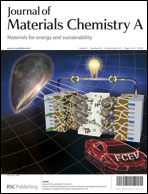Enhancing catalytic formaldehyde oxidation on CuO–Ag2O nanowires for gas sensing and hydrogen evolution†
Abstract
CuO–Ag2O nanowires are fabricated directly on the surface of an AgCuZn alloy via a facile method, which feature a hierarchical composition of the two oxides. The course of these nanostructures grown on the AgCuZn alloy substrate involves copper and silver co-crystallizing into hetero–oxides with acceleration of the rate by sacrificial zinc. Further, the prepared CuO–Ag2O nanowires display an improved electrocatalytic oxidation of formaldehyde to hydrogen and formate at room temperature. There is evidence showing that the mechanism of the electrocatalysis is a chemical-looping electro-oxidation of a high electroactivity intermediate Cu8O species, which is produced by formaldehyde reducing CuO. This uncommon reactive structure provides a route to monitor gaseous formaldehyde at the ppb level and generates much more hydrogen than CuO microparticles. The gas sensor exhibits an ultrahigh sensitivity of 52.40 μA ppm−1 cm−2 with a detection limit of 20.94 ppb, as well as response and restoring times of 2–5 s and 4–6 s, respectively. Besides, the speed of hydrogen evolution is also studied in this work (ca. 70 mL min−1 g−1), which is more than three times greater, and via a cleaner way, compared with CuO. Here we report an alloyed oxide nanostructure fabrication which suggests a method of facilely obtaining high performance catalytic materials.


 Please wait while we load your content...
Please wait while we load your content...